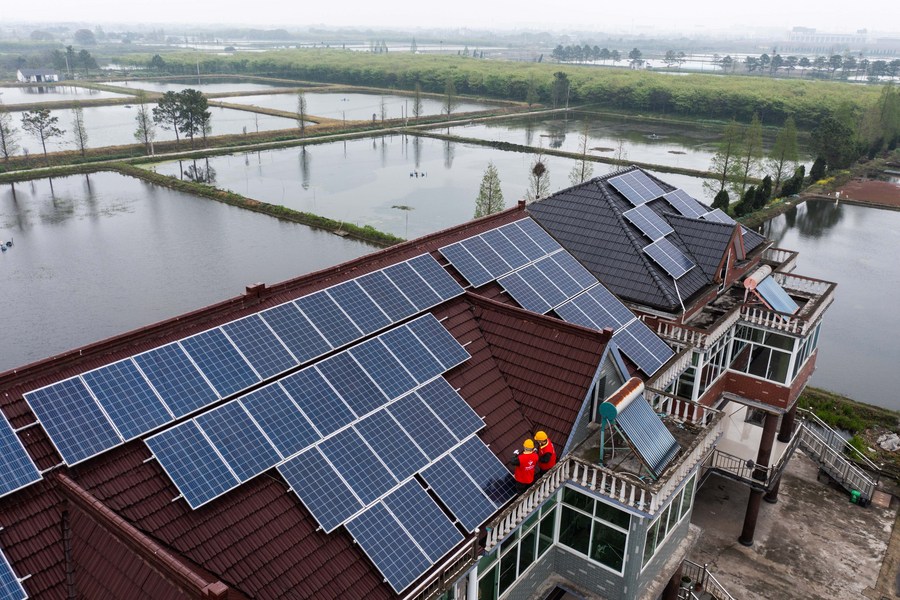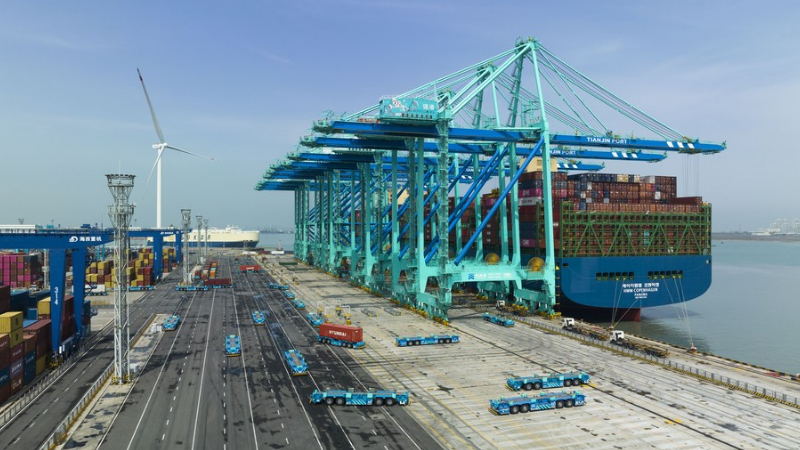*China has taken concrete steps to develop clean energies and plays a prominent role in the global fight against climate change.
*In recent years, rooftops have proven to be the ideal platform for further boosting the country's green development, especially for areas with plenty of sunshine and limited vacant space to build new land projects.
*As the current growth momentum continues, more sparkling days are clearly in sight.
BEIJING, April 21 (Xinhua) -- In Dinghuo Town, Yangzhou City in east China's Jiangsu Province, Zhu Qijie is a famous name. He is the first individual in the province who sold electricity to the national grid.
About 10 years ago when distributed photovoltaic (PV) power generation was budding in China, Zhu, an electromechanical worker, purchased necessary equipment and built a small PV power station on top of his roof.
In a year, Zhu's "rooftop power station," with an installed capacity of 5 kW, generated 6,000 kWh of electricity, which was enough to cover his household power consumption. From selling the remaining electricity to the power company and government subsidies, he secured an extra income of nearly 4,500 yuan (about 654.53 U.S. dollars).
The results exceeded Zhu's expectations and prompted him to expand the novel business by renting the empty rooftops of neighbors, friends and some local business buildings. Now, the total installed capacity of his rooftop PV projects has reached 300 kW, generating more than 200,000 yuan in profits every year.

Zhu Qijie checks his newly-built rooftop photovoltaic (PV) power station at Dinghuo Town of Yangzhou, east China's Jiangsu Province, June 4, 2013. (Photo by Si Xinli/Xinhua)
Driven by the ambitious goals of achieving carbon peak before 2030 and carbon neutrality before 2060, China has taken concrete steps to develop clean energies and plays a prominent role in the global fight against climate change.
Remarkable infrastructures, such as Asia's largest offshore wind plant in Jiangsu and PV power bases in the northwest Gobi Desert, have sprung up, while the launch of carbon markets and relevant policy tools have also achieved positive effects.
In recent years, rooftops have proven to be the ideal platform for further boosting the country's green development, especially for areas with plenty of sunshine and limited vacant space to build new land projects.
VIGOROUS EXPANSION
China is the world's largest producer and consumer of renewable energy, and has been the fastest-growing country in terms of newly installed PV power capacity in recent years.
In 2022, the country saw its newly installed PV capacity exceed 87 gigawatts, among which distributed PV added 51.1 gigawatts, up 74.5 percent year on year.
In Pingyin County, the famous "rose town" in east China's Shandong Province, rows of solar panels on top of villagers' roofs glisten under the spring sun, even more eye-catching than the vibrant flower fields.
Local villager Yang Guangying rented out her roof to a PV power company and is quite content with this decision. She said the clean electricity generated by the panels met the power demand of increasingly deepening mechanization in farming, and the rental was enough to cover her whole family's electricity bills.
According to the Pingyin branch of the State Grid, some 80 percent of 388 villages in the county have installed similar devices, which helps the county reduce carbon emissions by over 2,100 tonnes per month.

This aerial photo taken on Feb. 18, 2023 shows a photovoltaic (PV) power project in Liangzhou District of Wuwei, northwest China's Gansu Province. (Xinhua/Fan Peishen)
In Suzhou City, an economic powerhouse of Jiangsu, PV solar panels have been installed on top of the municipal government's office blocks. The city is planning to assess more public rooftops and cover over half of the suitable ones with solar panels within this year.
Beijing, the Chinese capital, has involved such projects in its latest urban planning, noting that the rooftop PV coverage of new public institution buildings, parks and factories will be no less than 50 percent, according to a recently released document.
Distributed PV power also fuels the green transition of enterprises. Nike's largest logistics center in Asia, located in Taicang, Suzhou City, has a rooftop PV installation of about 40,000 square meters that supplies about 33 percent of energy consumption for the facility and cuts carbon emissions by more than 2,600 tonnes per year.
BRIGHT PROSPECT
As the current growth momentum continues, more sparkling days are clearly in sight. Statistics show that in 2022, the total output value of China's PV industry exceeded 1.4 trillion yuan, with related exports reaching 51.2 billion U.S. dollars.
Gao Jifan, chairman of Trina Solar Co., Ltd., has been engaged in the PV industry for more than 20 years. He believes that there's still a lot of room for the development of rooftop PV projects.
With the market expanding, Gao said, the construction costs of PV projects have fallen, which further stirs up passion for private participation.

Staff members check the rooftop photovoltaic (PV) power installations for local villagers at Qixing Village of Deqing County, east China's Zhejiang Province, March 31, 2022. (Xinhua/Xu Yu)
Wen Xiaodong, general manager of a new energy company in Neihuang County, Henan Province, said that the average cost of PV installation has dropped from 5.5 yuan per watt in 2018 to some 4 yuan per watt this year.
His company now has a rooftop PV installation of 84,000 square meters.
"We think our return will cover all the investment by 2025," said Wen. "I'm very optimistic about the future of rooftop power stations."
Zhu, the first power seller in Jiangsu, has established his own PV equipment and installation company. Last year, he expanded his business overseas.
"The PV industry in our country is growing so well, which gives me more confidence in my business," he said.
(Video reporters: Chen Shengwei, Feng Yuanyuan, Wang Houyuan, Liu Jinhui, Guo Yuanyuan; Video editors: Zheng Xin; Zhao Xiaoqing) ■












